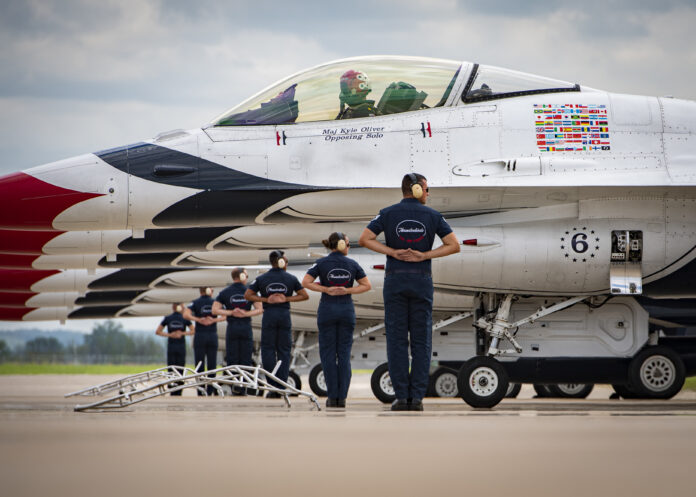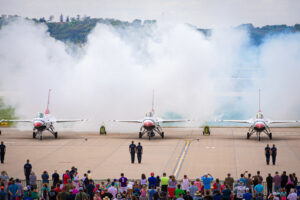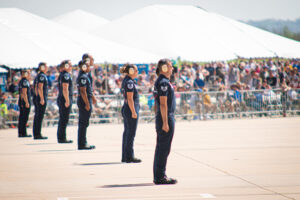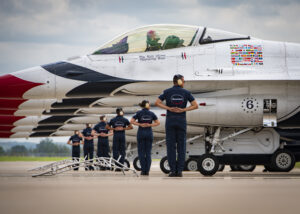
By Roger Mola
The lull in air shows last season nudged the Thunderbirds into rebooting their performance for the first time since 1983 when the team switched aircraft from the T-38A Talon to the F-16 Fighting Falcon. The Thunderbirds considered advice from team alumni, ICAS members, and former employees of Disney to assess what the air show fan craves and how to deliver an experience with more punch in less time.
As recently as 2019, the team’s ground display and aerial performance lasted 75 minutes. In 2021, the entire show will run 50 minutes.

Starting this April with its appearance at Cocoa Beach, Florida, the team unmasked the all-new production. The Thunderbirds pared 15 minutes off its aerial portion by scrubbing six maneuvers which repeated the same capability of its F-16 Vipers or pilots. At the same time, the team knows its sneak pass is a proven crowd thriller, and just may toss in an extra.
The Thunderbirds aerial portion is choreographed with new music and narration to span seven themes. After grabbing attention with a grand opening maneuver, the sequence enters a precision phase to showcase attention to detail and formation flight. At the midpoint of the performance comes the high-speed and motion maneuvers which highlight the performance of pilot and machine. Its aerial choreography then encompasses patriotic pride, strength and power, and grace and beauty, before an inspirational grand finale.
Its ground ceremony is ten minutes shorter and the crew now communicates with pilots solely by hand signals. The crew’s new gestures follow guidance from the Centers for Disease Control and Prevention (CDC) to reduce germs from speaking over the intercom, but also better match the practices of frontline Air Force personnel communicating with flight crews on a noisy airfield ramp.

Colonel John “Brick“ Caldwell is team leader and Thunderbird #1. He says that prior shows not only pushed the F-16’s fuel tank capacity nearly to landing on fumes, they equally tested the limits of a fan’s engagement. Until 2019, the Thunderbirds offered maneuver packages ranging from 25 to 47 minutes depending on weather conditions enabling a high, low, or flat show. Its remix now aligns the maneuvers so that, regardless of local environment or weather conditions, an air show fan sees 90 percent of the aerial maneuvers in the Thunderbirds menu. The team’s new low bomb burst hit maneuver is a modified version of the traditional starburst pattern, now possible even with a lower ceiling
“It’s easy to make a show longer by adding demos, but harder to cut things out,” says Caldwell, who compared the team’s prior performance to a stream of athletic moves like the Harlem Globetrotters. With the recent changes, the goal is now less clutter with more grace and choreography, like Cirque du Soleil. The Thunderbirds perform fewer segments, but ensure that each will spotlight a specific flight skill or aircraft ability and are not redundant to another portion of the team’s performance. Maneuvers have also been re-sequenced to ensure at least one aircraft is always at show center.
Colonel Caldwell knows that show organizers covet a military jet team to drive attendance, but some ICAS members told the team they want to reduce the time under temporary flight restriction (TFR) and return to airport to service, while also allocating more time to round its roster of performers.
Major Zane Taylor is in his second-year as a Thunderbird pilot and flies position #3 or right wing. He compares the new model to a fireworks show which rises in complexity with peaks and valleys rather than one finale.

“You bring people to a certain point and then reset,” says Taylor. “We pair the new music and narration to tell the person where to look,” using intelligent design to sync with the fan’s emotion. “Disney has been doing this so long, they basically have a mold.”
The Air Force consulted “at length” with former employees of Disney and concluded that their air show performance needed a series of arcs with a varying pace rather than a constant bombardment of the senses. The team’s show now begins with the most time-consuming of the set, a high-alpha slow pass, and then “resets your temporal perspective” by sliding into fast moves using afterburner.
Colonel Caldwell says the new sequence in seven themes “actually communicates something rather than feeling like a long series of exhibitions and maneuvers.” The ground ceremony is ten minutes shorter than 2019, but now imagines the procedures used in a combat theater during a rapid recovery after a sortie or after an alert to rapidly “generate” the F-16.
Captain Mike Bell, maintenance officer and Thunderbird #11, says that — with the ground crew demonstrating an alert launch — the show attendee develops a better understanding of the support skills the Air Force needs and that recruiters can talk up with prospective recruits at a show.

“Many of the folks we see on the road are not necessarily engaging where the military is at, so we’re showcasing the latest F-16 Block 52, and the fact that if you like servicing your car or mastering your computer, the Air Force has a place for you. [This] also sends a message to our adversaries that we have capability of rapid deployments,” says Bell.
Major Kyle Oliver joined as a new Thunderbird in 2020, but the lost season effectively makes 2021 his first flying slot #6 as opposing solo pilot. The new stinger break cross maneuver positions Major Oliver at his sneaky best.
“Four airplanes dive in toward show center with smoke on to look like they are on a collision course and it’s designed so the crowd forgets about me,” says Oliver, who has snuck beyond the spectator field of view. “Then I turn smoke off and time my entry [into the maneuver] to sneak in at 500 feet above ground level just shy of the speed of sound.” Oliver says his solo air show maneuvers mirror a combat pilot’s show of force over an enemy as a warning of escalation.
Major Remoshay “Flare” Nelson serves as Thunderbird #12 and public affairs officer. Nelson says, that, despite the lost air show season, last year’s America Strong tour to honor first responders, “…made up for 93% of the team’s publicity value for 2020,” and brought lots of positive exposure and coverage.
 In 2020, the Thunderbird metrics largely centered on its digital traffic and engagement. The team typically estimates the number of spectators they reach at an air show site, but — in the absence of live shows — now reports its digital impressions with similar flair.
In 2020, the Thunderbird metrics largely centered on its digital traffic and engagement. The team typically estimates the number of spectators they reach at an air show site, but — in the absence of live shows — now reports its digital impressions with similar flair.
Major Nelson says the 2020 flyovers passed over 248 hospitals in nine states, refueling in flight to minimize the time its support staff spent congregating at ground stations, but still managing 75 “media engagements.” Thunderbird flyovers were praised by social media influencers, President Trump, senior military and political figures.
With most air show fans chocked to their couches, the Thunderbird online traffic enjoyed 128% growth in new followers on social media. “Most were gained on Twitter,” says Nelson, who said 60% of users fall within the Air Force target age range for recruiting.
“The Thunderbirds reached billions through media exposure and approximately 38 million through social media and yielded a publicity value of over $307 million by extending its online reach to six continents,” said Nelson. “We brought air power to the general population by flying over major cities instead of the general population coming to air shows to see and experience the air power of the U.S. military.”







